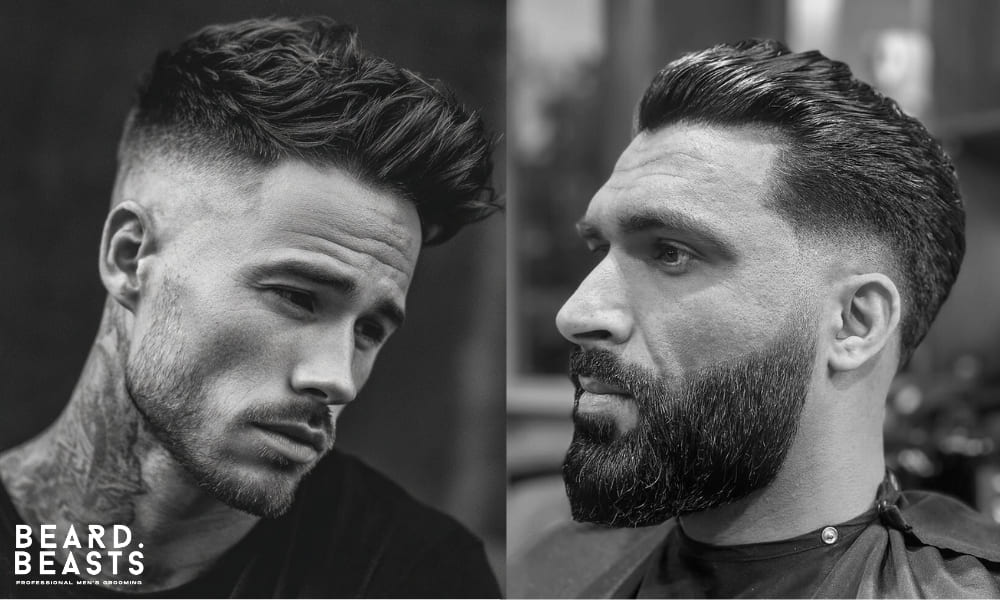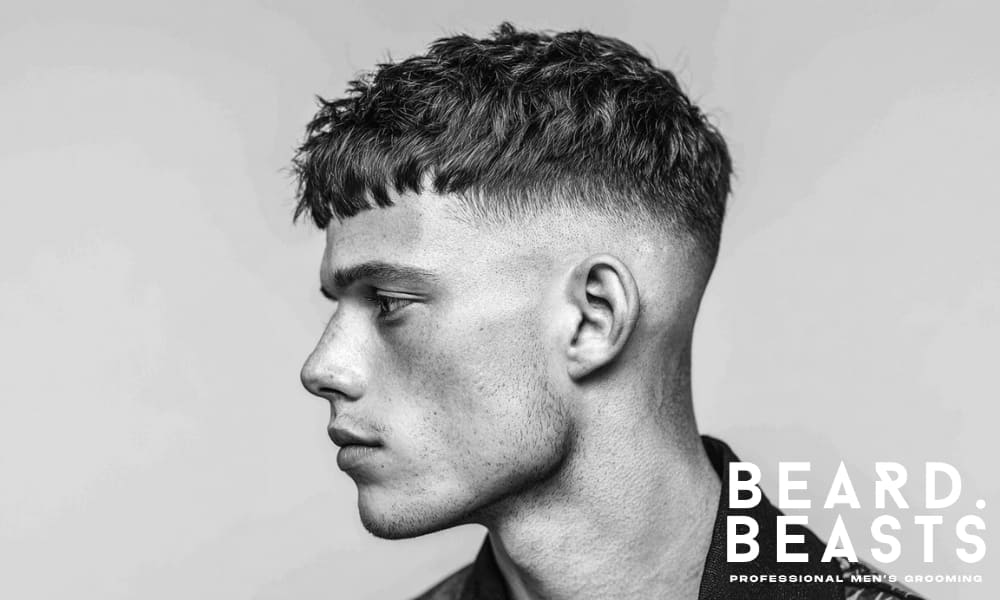Ready to transform your look, but unsure which fade to choose? The difference between a low fade vs high fade might seem small—but it completely changes the way a haircut looks and feels. One creates subtle structure, the other brings bold contrast.
Knowing which one suits you best comes down to more than preference. It’s about your face shape, your style, and how you want to carry your look day to day.
What Is a Low Fade?

A low fade features a gradual taper that begins just above the ears and curves around the neckline, seamlessly blending the hair into the skin. It offers a clean, polished finish without drawing too much attention to the fade itself, making it an ideal choice for men who prefer subtlety over bold contrast.
The transition is soft and controlled, creating structure around the sides while allowing the style on top to take the lead. Whether you’re wearing a classic crop, textured fringe, or a slick back, the low fade gives the cut a refined edge without overwhelming the overall shape.
Key Features of a Low Fade:
- Starts low on the head, offering a clean, understated finish.
- Creates natural structure without harsh contrast.
- Ideal for professional and everyday styles.
- Pairs well with most top lengths and hair types.
- Low-maintenance with longer-lasting shape between cuts.
What Is a High Fade?

A high fade starts much higher on the head—usually above the temples—and creates a sharper, more aggressive contrast between the top and the sides. It quickly tapers down to the skin, exposing more of the scalp and placing full focus on the hair above.
This bold placement adds edge and intensity to any style, making it a go-to for men who want a statement cut. The high fade is often seen in more modern, trend-driven looks, but it can also add striking definition to classic styles like the pompadour or quiff.
Key Features of a High Fade:
- Starts high on the sides for bold contrast
- Creates a sharp, modern look
- Highlights the shape and volume of the top
- Ideal for trend-forward or edgy styles
- Requires more frequent touch-ups to stay crisp
Key Differences Between a Low Fade vs High Fade

Understanding the key differences between a low fade vs high fade helps you choose a style that complements your face shape, grooming routine, and personal image. Here’s how they differ where it matters most.
Starting Point
Where the fade begins defines the foundation of the entire haircut.
Low Fade:
- Begins just above the ears
- Blends gradually into the neckline
- Offers a more subtle, grounded structure
High Fade:
- Starts above the temples
- Drops quickly to the skin
- Creates a sharper, more aggressive transition
Visual Impact & Contrast
How bold or refined your haircut looks depends on the strength of the fade line.
Low Fade:
- Creates a soft, natural blend
- Keeps the focus on the top style
- Suitable for classic and understated looks
High Fade:
- Produces a high-contrast, sculpted appearance
- Exposes more scalp and sharp lines
- Stands out as a defining style element
Versatility with Top Lengths & Styles
Some fades give you flexibility, others demand a specific top shape.
Low Fade:
- Complements short, medium, and longer styles
- Works with textured, clean, or tousled finishes
- Blends well into nearly any haircut
High Fade:
- Best suited to cropped, high-volume, or defined shapes
- Adds edge to short tops like buzz cuts and faux hawks
- Can overpower softer, longer styles if not balanced
Suitability for Face Shapes
The right fade can sharpen your features—or throw off facial balance.
Low Fade:
- Elongates the face subtly
- Enhances oval, square, and heart-shaped faces
- Keeps facial proportions neutral
High Fade:
- Adds vertical height and structure
- Slims wider or rounder face shapes
- May exaggerate length on narrow faces
Maintenance & Grow-Out
Fade placement affects how quickly your haircut loses its edge.
Low Fade:
- Grows out gradually with less visible change
- Holds shape longer between cuts
- Easier to maintain with fewer visits
High Fade:
- Loses sharpness quickly as hair grows
- Requires more frequent trims and touch-ups
- Best for men who prefer a crisp, fresh look at all times
Overall Vibe / Impression
Each fade reflects a different grooming mindset and personal style.
Low Fade:
- Professional, clean, and low-key
- Fits formal, classic, and understated styles
- Balanced without being too bold
High Fade:
- Modern, bold, and attention-grabbing
- Suits trend-driven or athletic looks
- Ideal for men who want their haircut to make a statement
Ultimately, the difference between a low fade and a high fade extends beyond just their starting point. These variations profoundly impact your overall style, desired contrast, and daily grooming commitment.
Both offer sharp, refined results when executed with precision, making your choice a reflection of these key factors.
How to Choose Between a Low Fade and a High Fade
The decision between a low fade vs high fade goes beyond trends or Instagram inspiration. To get a fade that actually works for you, it needs to align with your face shape, hair type, daily routine, and how you want to present yourself.
Here’s how to break it down with clarity.
How Bold Do You Want Your Look to Be?
The strength of your fade directly influences how loud or understated your haircut feels.
Choose a Low Fade if you want:
- A subtle, refined look that blends naturally
- Clean structure without drawing too much attention
- The top of your hair to remain the focal point
Go for a High Fade if you prefer:
- A bold, dramatic haircut with visible contrast
- Sharp, sculpted sides that stand out immediately
- A modern edge that lifts the overall style
What’s Your Face Shape and Head Structure?
The right fade should balance your natural features, not compete with them.
Choose a Low Fade if you have:
- A round, oval, square, or heart-shaped face
- A preference for soft structure and balanced shape
- A head shape that suits less aggressive tapering
Go for a High Fade if you have:
- A wider or rounder face that benefits from vertical height
- Strong cheekbones or jawlines that deserve definition
- A head shape that can handle sharper lines and exposure
What’s Your Hair Type and Top Length?
Your hair’s natural texture and length can determine which fade will blend best.
Choose a Low Fade if you want:
- A versatile cut that works with short, medium, or long tops
- Seamless blending into textured, clean, or tousled styles
- A fade that supports flexibility in daily styling
Go for a High Fade if you prefer:
- A cut that supports cropped, spiked, or structured volume
- High-impact styles like quiffs, buzz cuts, or pompadours
- A fade that becomes a standout feature of your look
How Much Maintenance Are You Willing to Commit To?
Your grooming schedule should match the demands of your fade.
Choose a Low Fade if you want:
- A low-maintenance option with a slower grow-out
- Fewer barber visits—usually every 3–4 weeks
- A haircut that holds its shape without constant attention
Go for a High Fade if you’re ready for:
- Frequent upkeep to preserve sharp contrast
- Barber visits every 1–2 weeks to stay fresh
- A style that loses precision quickly as it grows
What Vibe Do You Want to Project?
Fades shape perception—choose one that mirrors your personal identity.
Choose a Low Fade if your style is:
- Classic, clean, and professional
- Balanced and suited for formal or traditional environments
- Focused on subtle grooming over bold statements
Go for a High Fade if your style is:
- Modern, edgy, and fashion-forward
- Built to turn heads and command presence
- More aligned with streetwear, fitness, or bold styles
Consult Your Barber
Even with a clear guide, the best call comes from working with a skilled barber. They can assess your hair growth, head shape, and texture to tailor the fade to your individual needs. Bring reference photos, ask questions, and be honest about your styling habits.
Final Thoughts
Choosing between a low fade vs high fade isn’t about following trends—it’s about knowing what works for you. Your haircut should enhance your features, suit your lifestyle, and reflect the way you want to carry yourself.
Both fades deliver precision, structure, and style—but the right one sharpens your look without trying too hard. Whether you lean subtle or bold, polished or powerful, the best fade is the one that’s deliberately chosen—and flawlessly executed.





